AC Milan beat Frosinone 3-1 at San Siro to make it back-to-back wins in Serie A. The Rossoneri secured the victory courtesy of goals from Luka Jovic, Christian Pulisic and Fikayo Tomori before the away team scored a late consolation.
It was a largely uneventful opening 45 minutes but two pivotal moments occurred shortly before the interval. Firstly, in the 42nd minute, Tomori went unpunished after getting caught in possession by Marvin Cuni. After dispossessing the Milan centre-back, the Frosinone striker was 1v1 with Mike Maignan but the French goalkeeper came out on top in the duel.
A minute later, Simone Romagnoli was not as fortunate following his unforced error. The Frosinone defender’s inaccurate pass was easily intercepted by Pulisic who sprung a Milan counterattack which concluded with Jović reacting first to a loose ball inside the box to volley home his first goal for the club.
In the second half, a pinpoint Maignan long pass was deftly controlled and finished by Pulisic to put Milan into a 2-0 lead in the 50th minute. From this point, Frosinone maintained control of the ball but without creating any genuine danger. That was until the 74th minute, when Milan put the victory beyond any doubt, after Tomori finished from close-range at the second-phase of a corner kick.
Frosinone did pull one goal back in the 82nd minute when an inswinging wide free-kick, deep in the Milan half, evaded everybody to bounce into the net. In truth, it was a comfortable, if not spectacular, home victory. @Tactics_Tweets provides his observations of the game…
Set-ups
Stefano Pioli was again forced into making changes to his starting eleven. Replacing Malick Thiaw in the heart of defence was Theo Hernández, which made room for Alessandro Florenzi to come in at left-back. In midfield, Yunus Musah started ahead of Yacine Adli and in attack, Luka Jović switched in for the suspended Oliver Giroud.
In defensive phases, the home team reverted to type, using their usual player-orientated approach (man-marking) in central midfield which gave the hosts formation a 4-2-3-1 resemblance. Then, in attacking phases, Milan primarily maintained their 4-3-3 shape in the first half, with their full-backs retaining the width. But in the second half, there was a slight adjustment which we’ll come onto.
For Frosinone, manager Eusebio Di Francesco made two changes to the side which beat Genoa the previous match week. The away side operated out of a 4-3-3 shape in possession, with Matìas Soulé predominantly coming infield to get involved in play meaning a teammate (either right-back or right-sided central midfielder) occupied the width on the right. Out of possession, the visitors switched between a 4-4-2 when defending high, and a 4-5-1 when defending lower.
Superior individual quality
In the first half, when Milan were in possession, their 4-3-3 base maintained its overall structure but adapted in the different thirds of the pitch. In build-up phases, Tomori and Hernández split wider across the pitch which both stretched Frosinone’s first line of engagement and allowed Maignan to act as a third centre-back from the top of his area.
Reijnders primarily operated a single pivot ahead, offering various angles for ball progression. If wide progression and retention was required, full-backs, Calabria and Florenzi, were available for passing options via the flanks. Milan’s midfield 8s, Loftus-Cheek and Musah, could each drop to help with build-up, but mainly operated in the spaces behind the opposition midfield line.
In the forward line, Jović stayed central to occupy the Frosinone centre-backs. Either side of him, Chukwueze provided the width on the right flank, whereas Pulisic was more dynamic in his positioning from the left-hand side. The USMNT forward was involved and initiated much of Milan’s best attacking moments in the opening forty-five minutes.
As Milan progressed into the opposition half, their full-backs offered both over-and-underlapping runs. On the left wing specifically, Hernández could even push up from his centre-back position too, with a teammate dropping behind to cover. But despite Milan’s higher possession share in the first half (56%), their attacking threat was fairly limited.

Here are some examples in practice of Milan in possession, and reasons for their stunted penetration.
In the visual below, taken from the 7th minute, there is an example of the Milan players forming the team’s attacking structure, as play progressed into the Frosinone half. Reijnders was in possession in front of the opposition 4-5-1 block, the Milan full-backs were holding their width, likewise their wide forwards, the midfield 8s were advanced between the lines, and Jović was leading the line.
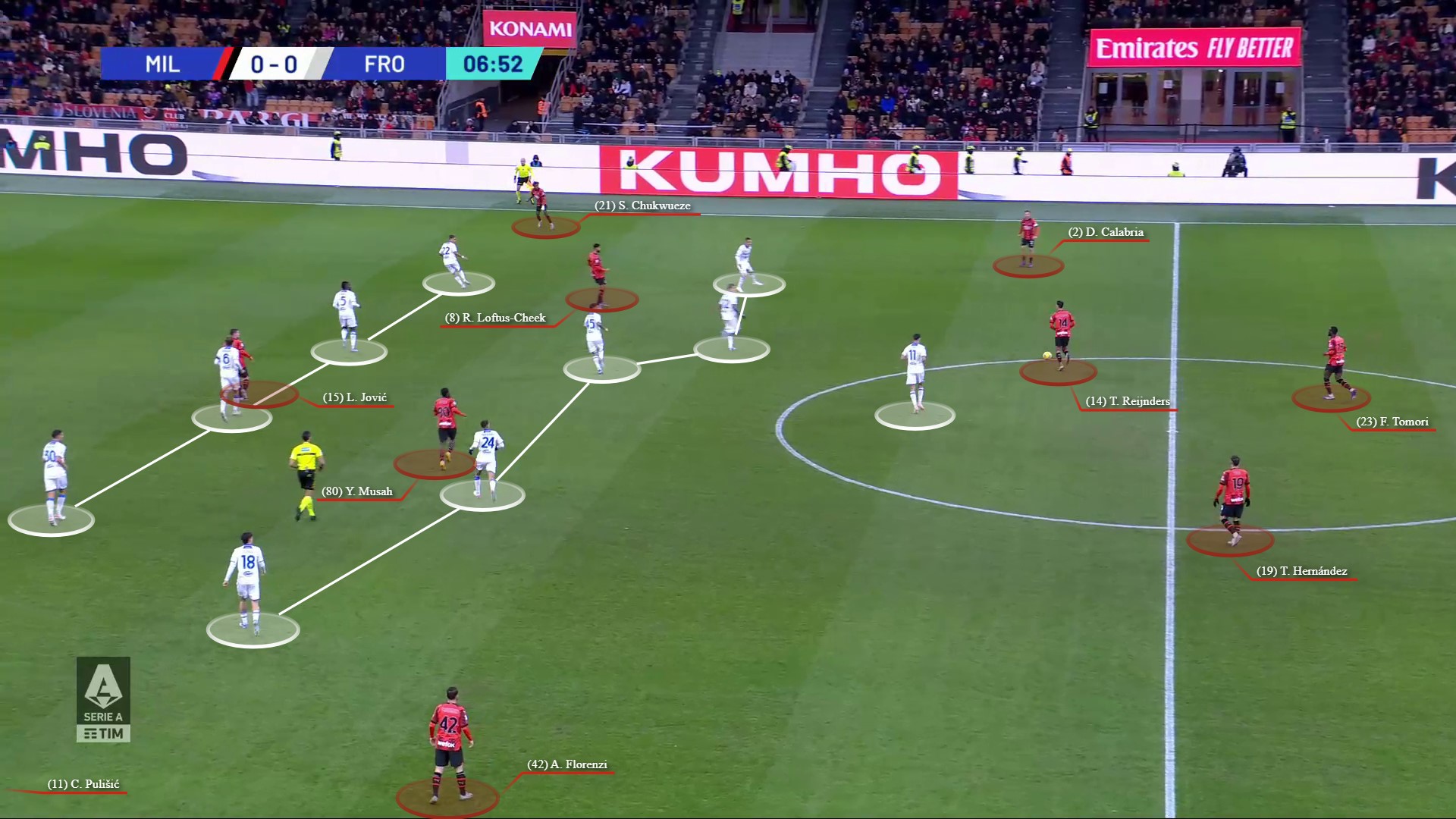
In this attacking sequence, from the 20th minute, Reijnders dropped to receive a pass from Tomori which (as Frosinone were trying to engage higher up the pitch) resulted in Reinier jumping from the midfield line to form a situational 4-4-2.

After Reijnders had evaded the pressure, Milan worked possession over to their left-hand side where Pulisic had roamed infield to help with further progression. Below, you can also see how Florenzi advanced high to occupy the Frosinone right-back and Reinier was beginning to drop, to form his side’s lower 4-5-1 block.
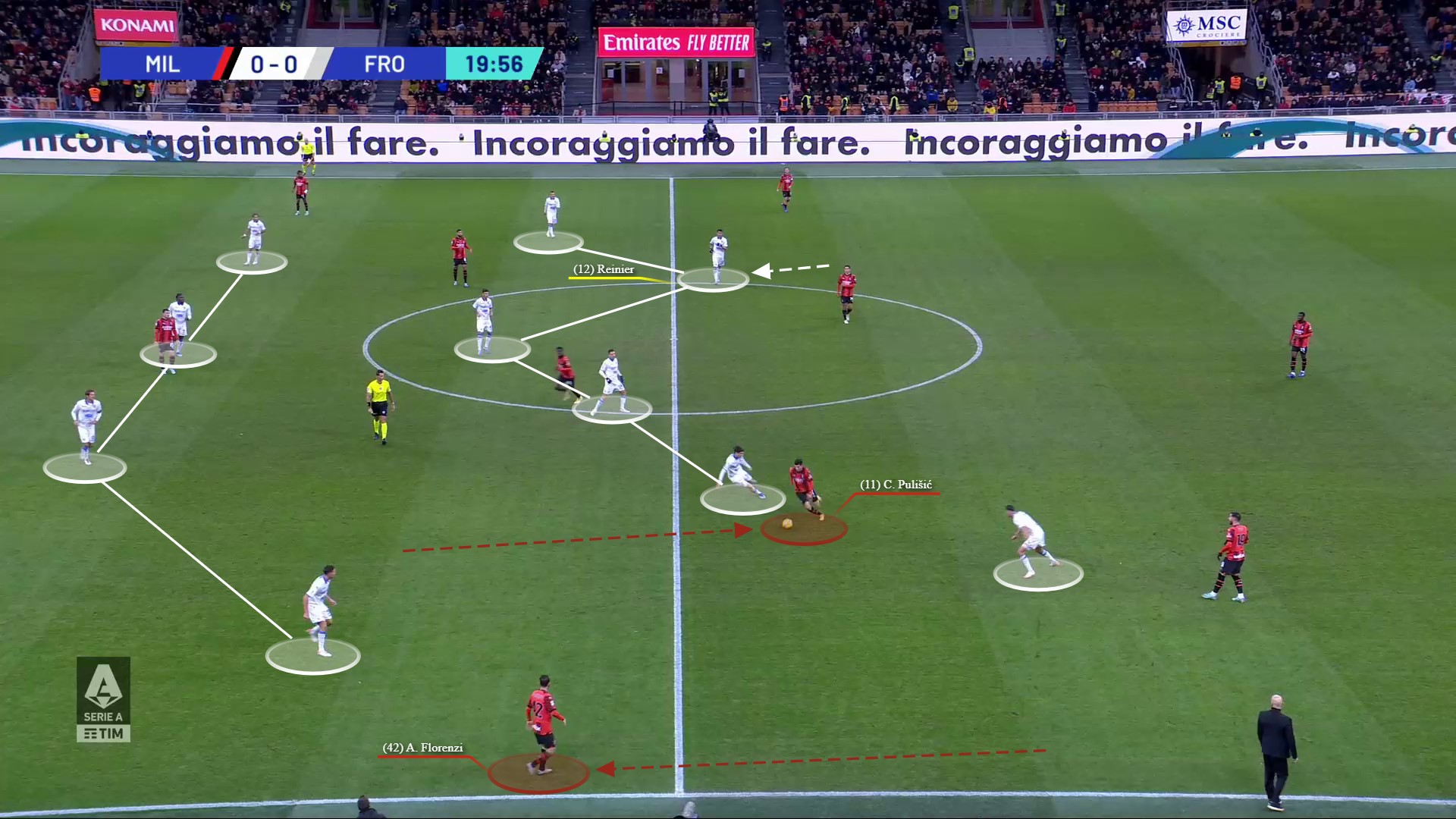
After a Pulisic carry infield, he found Reijnders who played a line breaking pass into Musah who then slid in Florenzi who was free wide left, as one of Milan’s most advanced players.

However, one of the downsides of having a full-back in this position, as opposed to an attacking player, is a reduction in quality. And in the above instance, Florenzi’s poor first touch meant any chance to find Jović across the face of goal was missed. Although, the makeshift left-back did at least manage to win his side a corner kick.
Another downside for Milan was, often by the time they accessed their attacking talent in opposition territory, the opponent was able to get back into their defensive shape making it difficult to create chances. And these type of instances, like the above and below, were symptomatic of Milan’s limited attacking threat in the first half.

So whilst Milan may have taken the lead in the 43rd minute, the attack came about from a Frosinone ball loss. Therefore, with improvements to be made, at half-time Pioli decided to make an adjustment to his side’s attacking structure. And part of the new offensive gameplan involved trying to get Pulisic in more situations where his effective performance could cause Frosinone more damage.
As can be seen below, Milan did this by altering Florenzi’s position in build-up phases. With the left-back moving infield, instead of advancing, it helped draw the right-sided Frosinone midfielder infield…
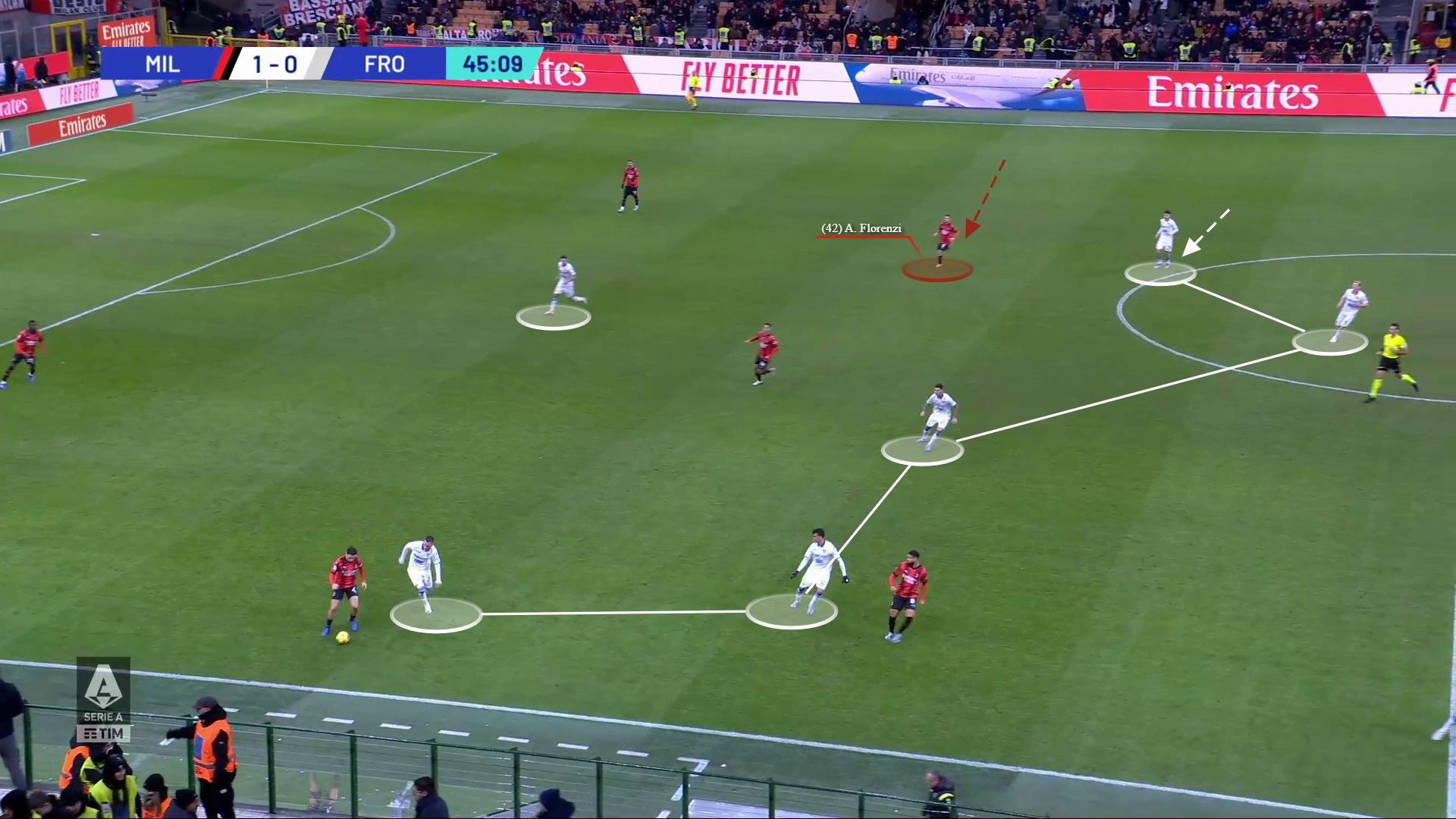
…and this enabled Pulisic to stay high.

A minute later, Pulisic’s new higher position was visible once again. In this scenario, Florenzi moved infield during second-phase build-up, dragging the opposition right winger with him.

After recycling possession, Milan managed to make a pass through the lines into Jović who had the option of Pulisic free, and calling for the ball, on the left wing but laid the ball off to the nearer Chukwueze to attack down the right-hand side.
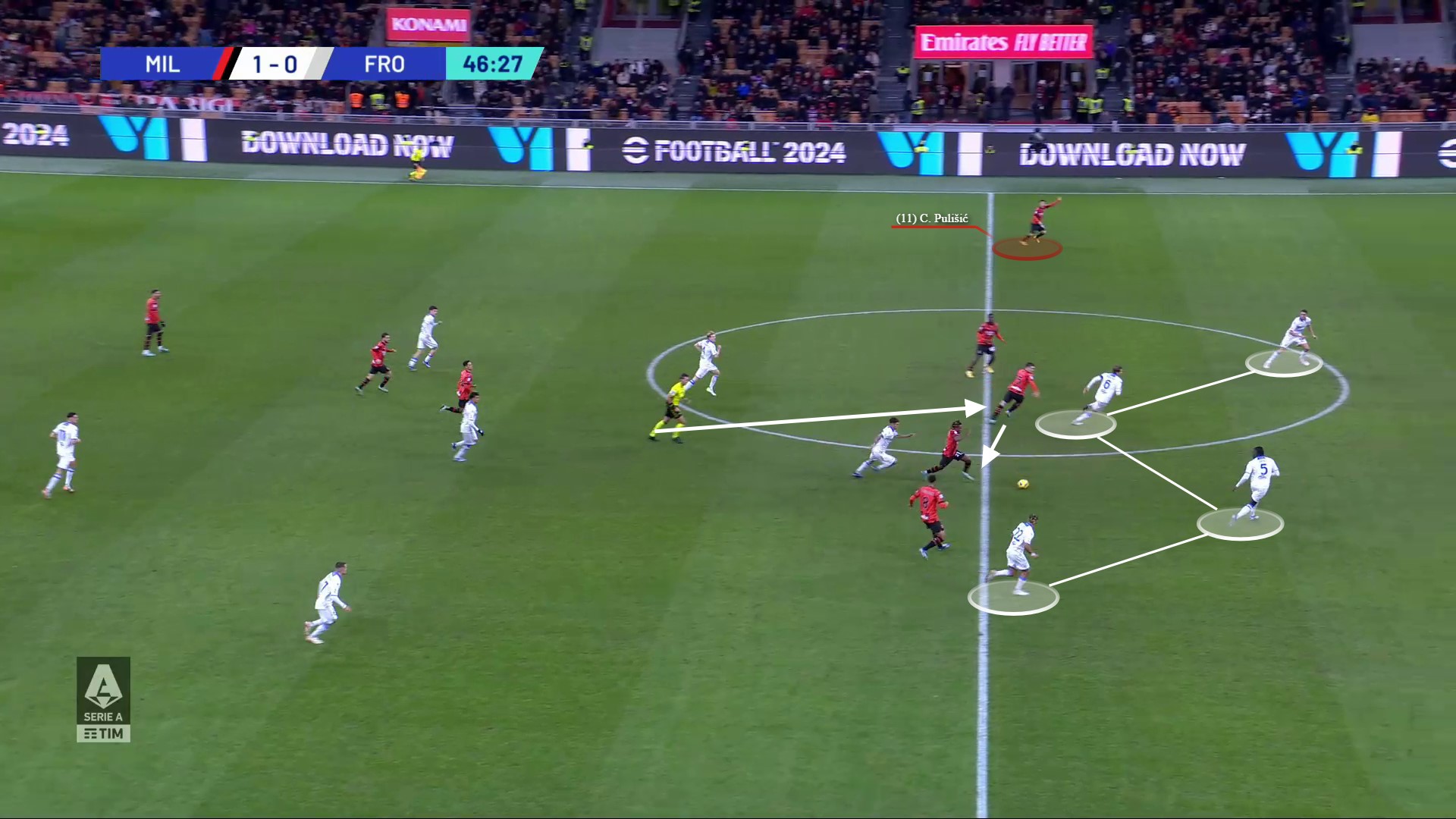
Whilst these two early passages of play did not utilise Pulisic’s more advanced position, this next attack did. Milan had possession in the middle third of the pitch, with Florenzi infield, and with Pulisic in space out wide, Musah made a pass to the left wing.

Now, in a 1v1 against the Frosinone right-back, Pulisic continued his first half positivity by beating his opponent, before crossing into the box which Chukwueze met but headed over.

In the 50th minute, Pulisic’s focus on staying high, also played its part in their second goal. Below, you can see Milan’s set-up when Maignan had possession in front of the Frosinone high block. With space in behind to exploit, the two Milan teammates were on the same wavelength but that’s not withstanding the quality required to execute the long pass, control and then finish.
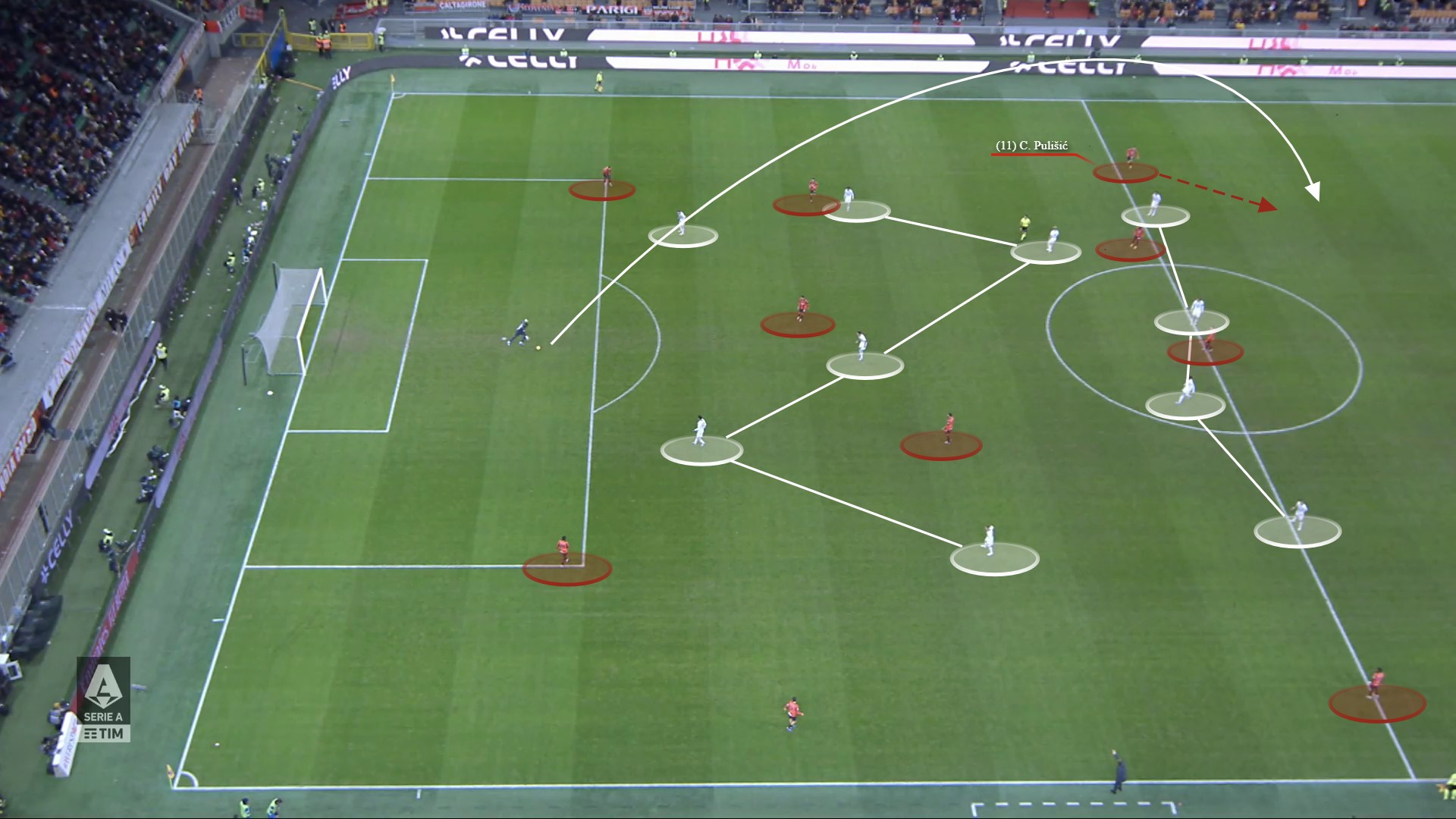
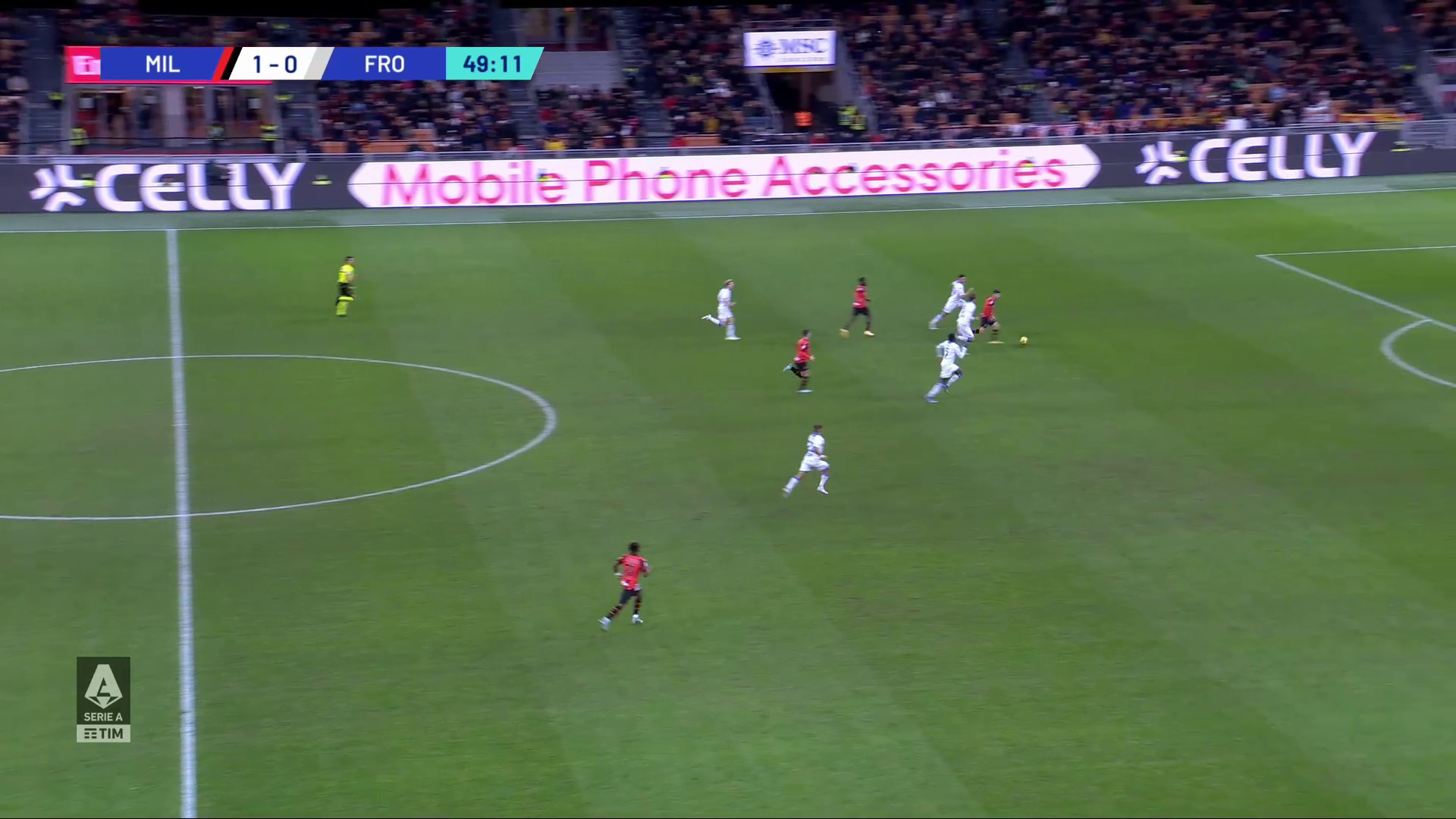
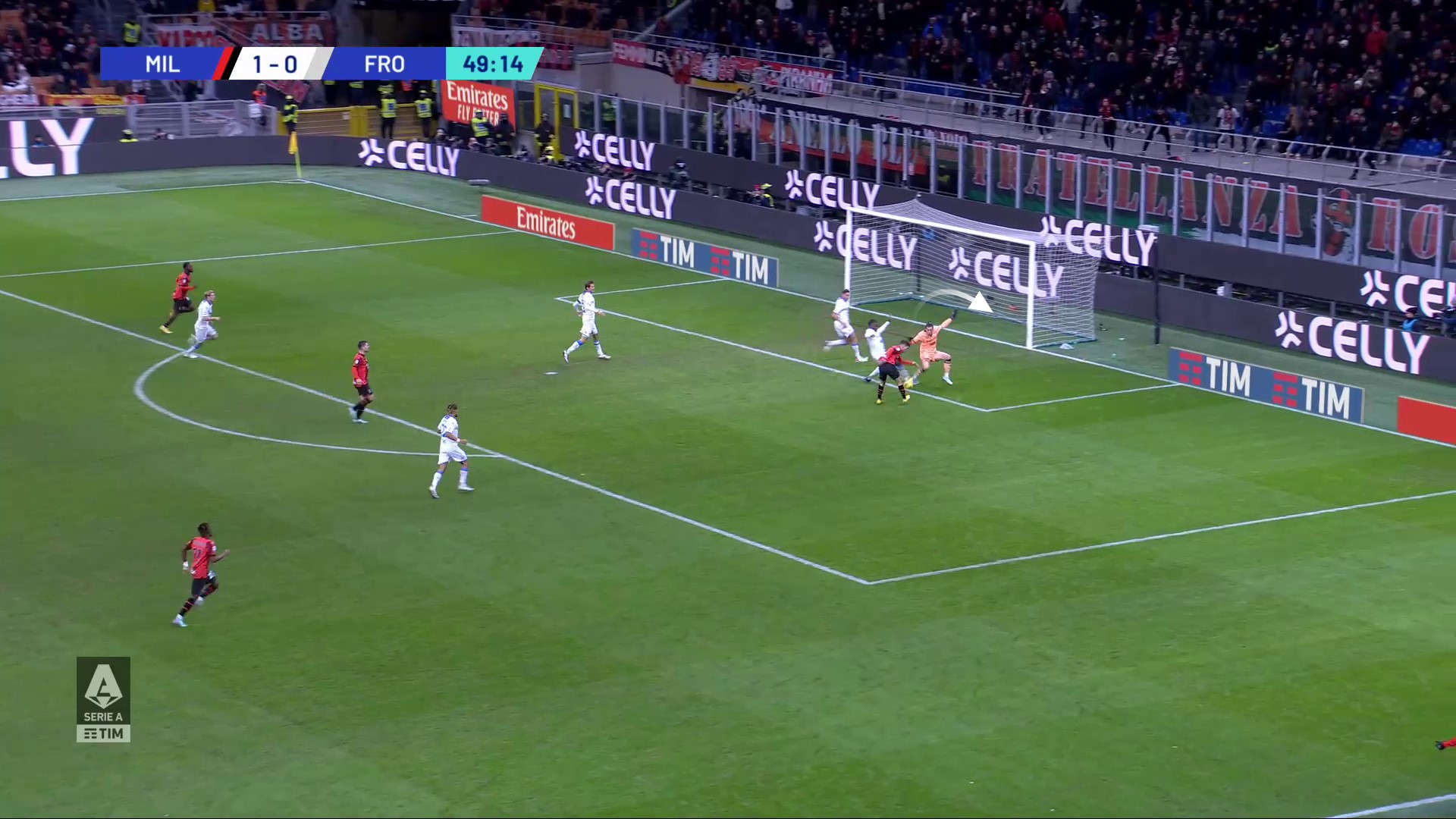
The difference in attacking quality, on either side, ultimately made the difference in this fixture. This was evident not only at the end of the first half – where Cuni failed to capitalise upon Tomori’s error whereas Jović made no mistake when it came to compounding Romagnoli’s – but also in Milan’s second goal.
After going two goals up, the home team comfortably saw out the remainder of the game, despite Frosinone having the majority of the ball and multiple attempts on goal. And much of this can be owed to Milan’s approach in defensive phases.
Player-orientated defensive phase
Out of possession, Milan used their most typical approach in defensive phases – being player-orientated in central midfield and then allowing an underload (-1) in their forward line to maintain an overload (+1) coverage in their backline. The exception to this was within their pressing-scheme where the ball-side full-back would jump to engage the free opposition full-back if found.
The primary aims of this approach are to reduce the opposition’s passing options, with all ball-near opponents being covered by a Milan player. As a result, Milan can force 1) turnovers in the opposition half or 2) rushed – and therefore lower quality – forward passes which the Milan backline (with the additional player) can then intercept and regain possession.
This out of possession approach was visible immediately from kick-off. Jović curved his pressing run to block off access to the far-side centre-back and with no (safe) short passing option available…

…an aerial pass was made into the forward line, that Hernández could engage with Tomori able to cover, and Milan used their player advantage to regain possession.
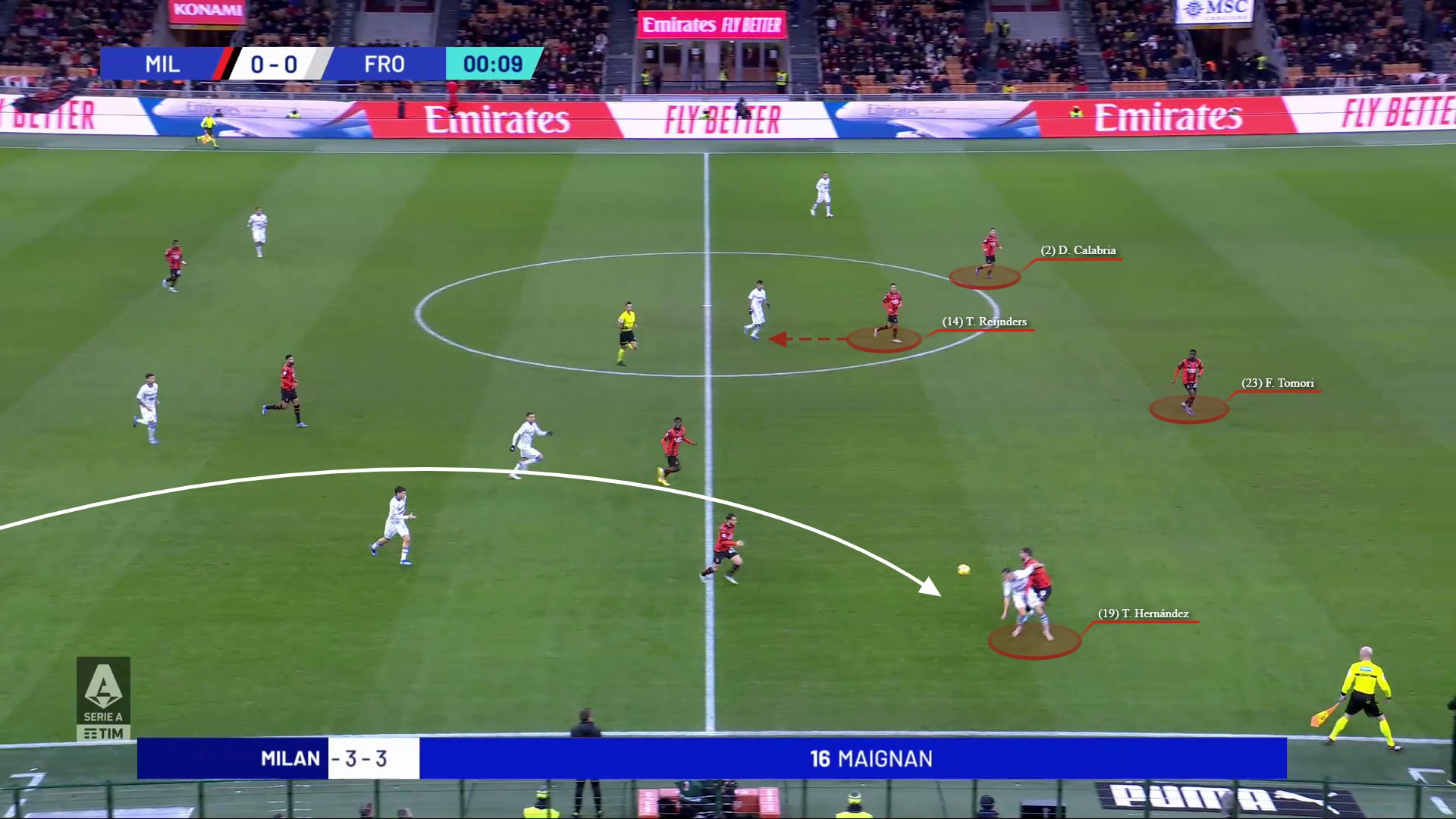
And this pattern continued throughout the game. Here, in the 10th minute, Milan forced a high turnover. The forward line of three locked onto three of the Frosinone back four, squeezing the opponents onto one-side of the pitch – allowing a far-side weakness (free opposition right-back) but making it difficult to find.
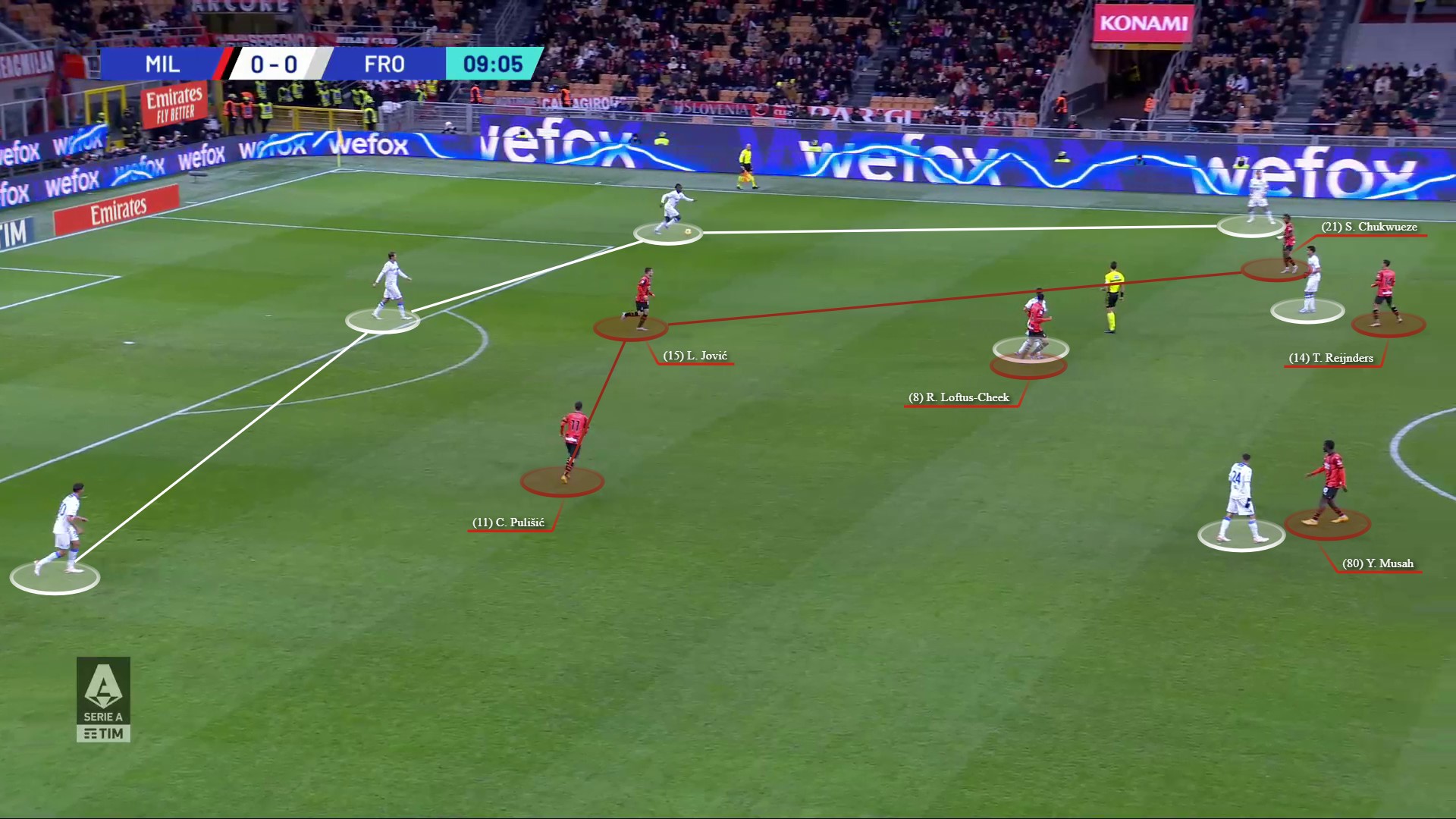
But with all Frosinone central midfielders being closely tracked by Milan opponents, the pass into midfield forced a turnover which generated a counterattack.
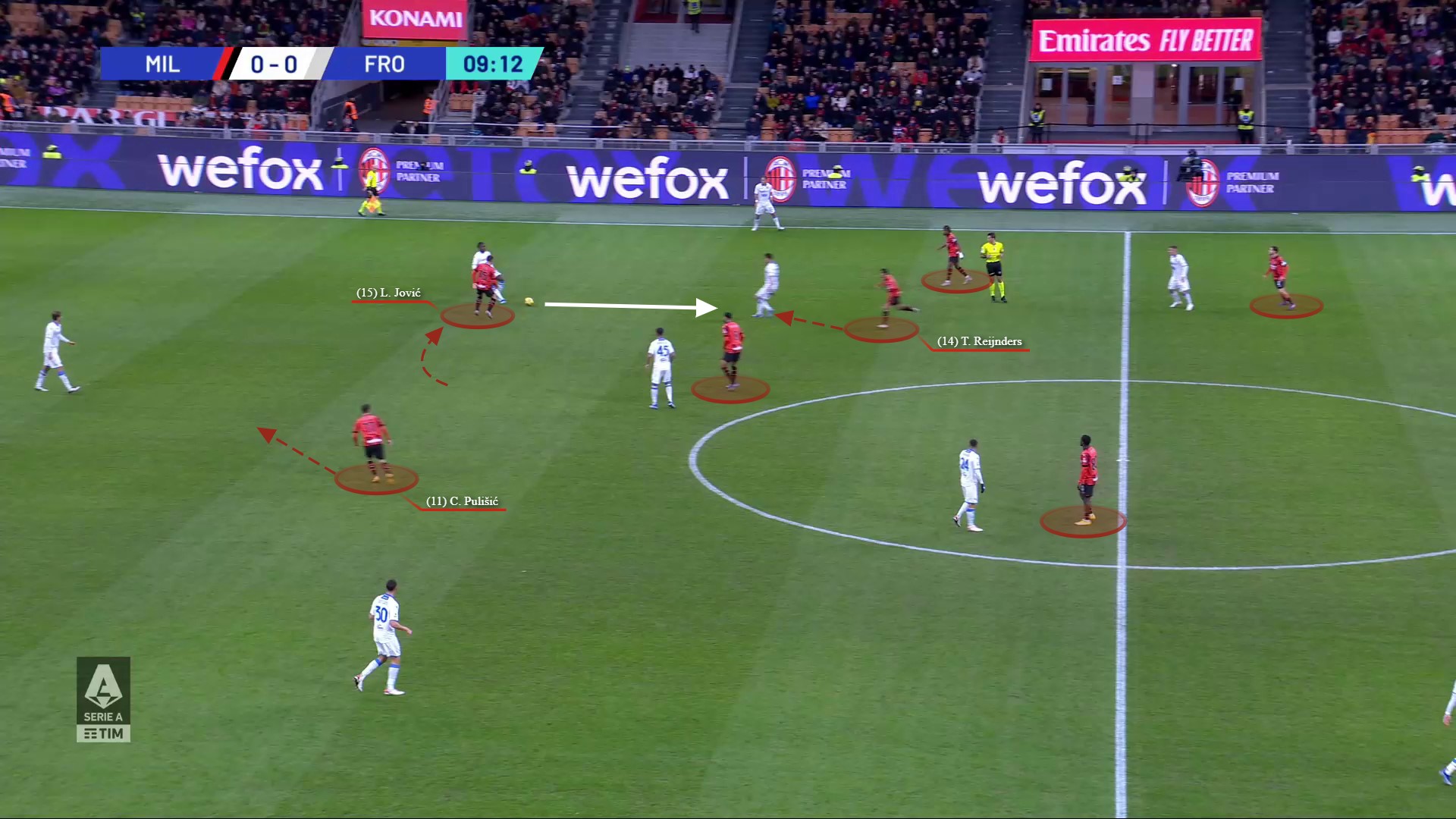
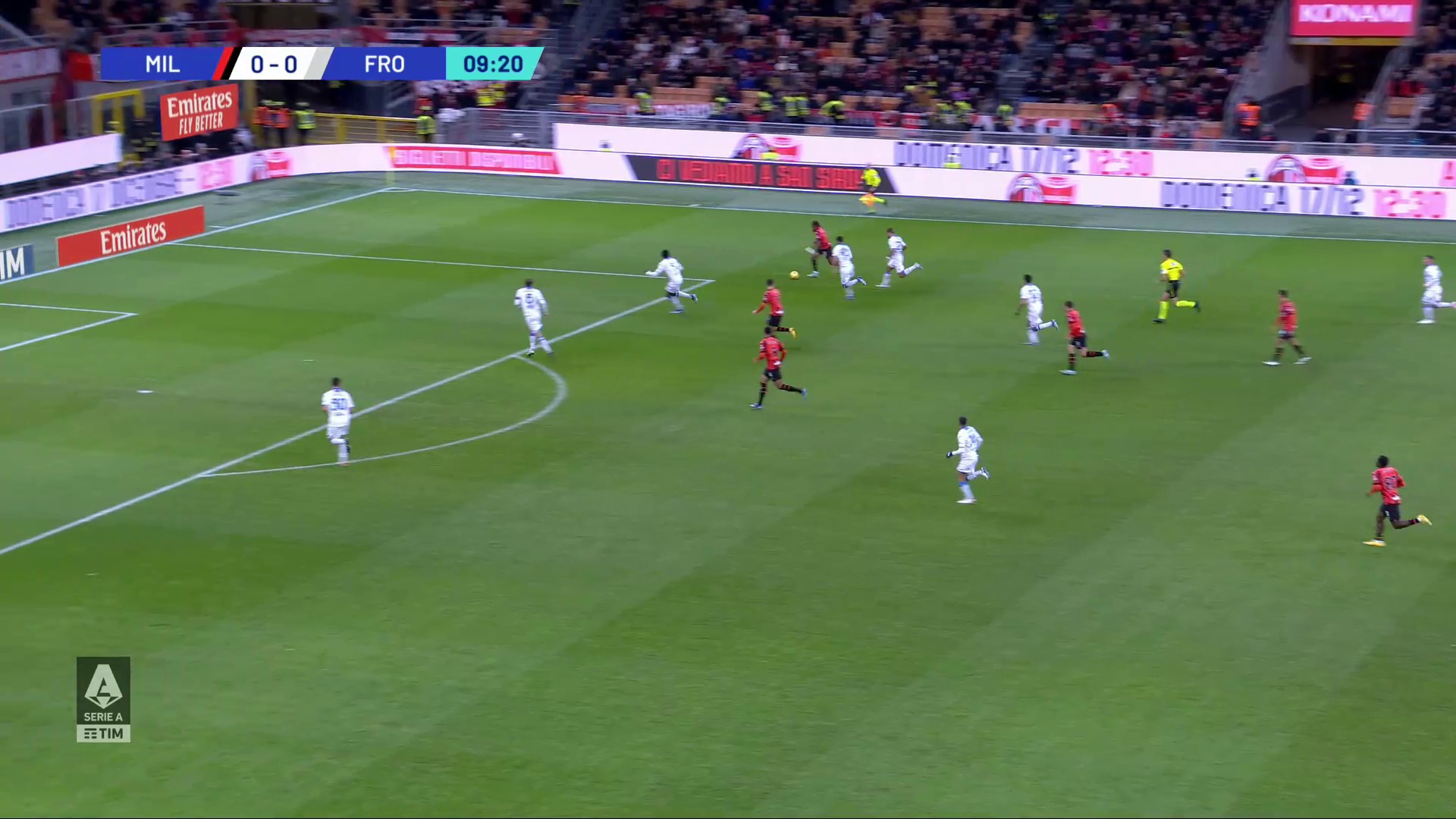
Even on the occasions when Frosinone were able to play through the first lines of Milan pressure, the home team had the safety blanket of an additional defender in their backline to step out and engage the danger. This was evident in the 31st minute when Frosinone played out via their left-hand side.
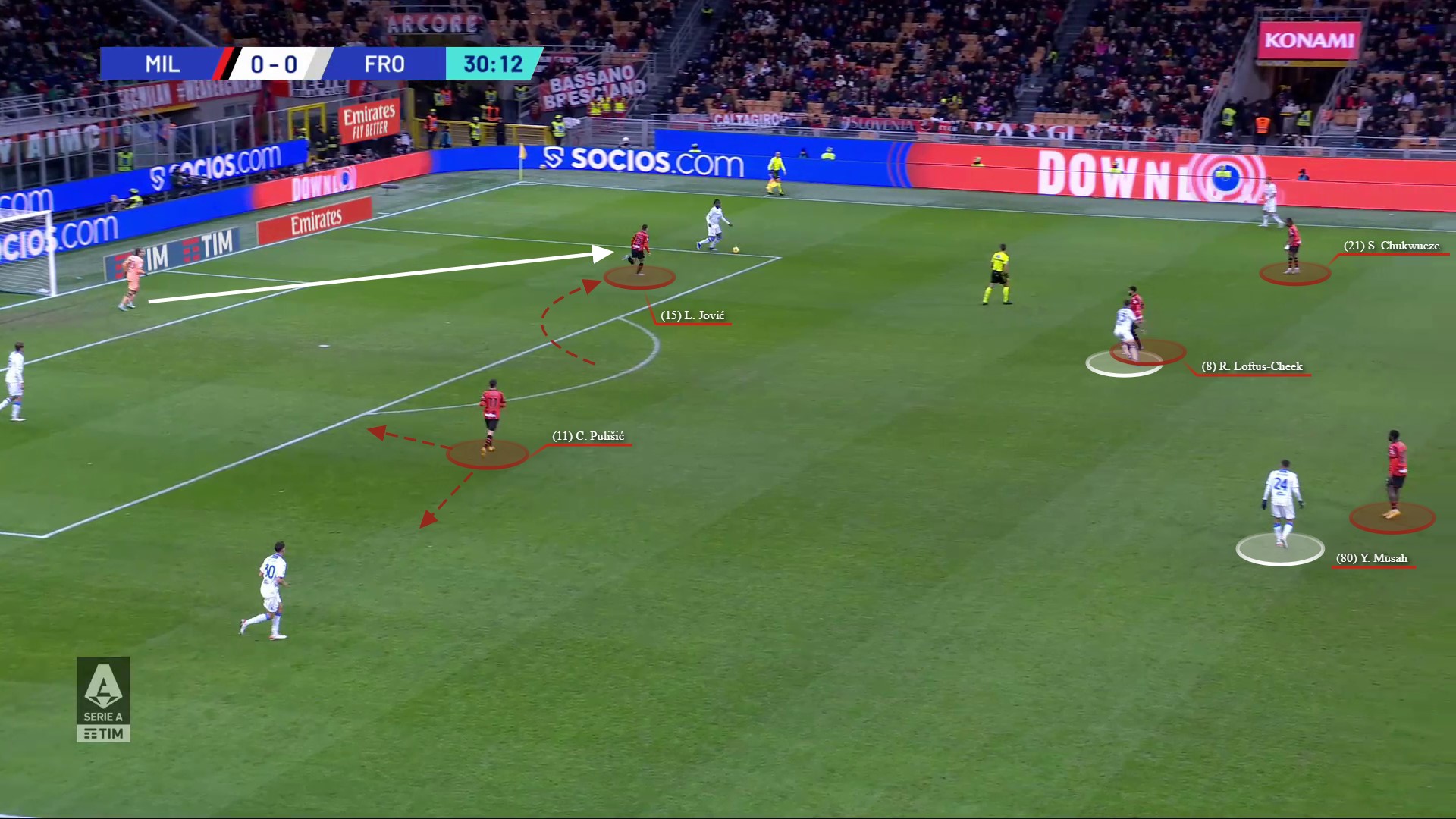
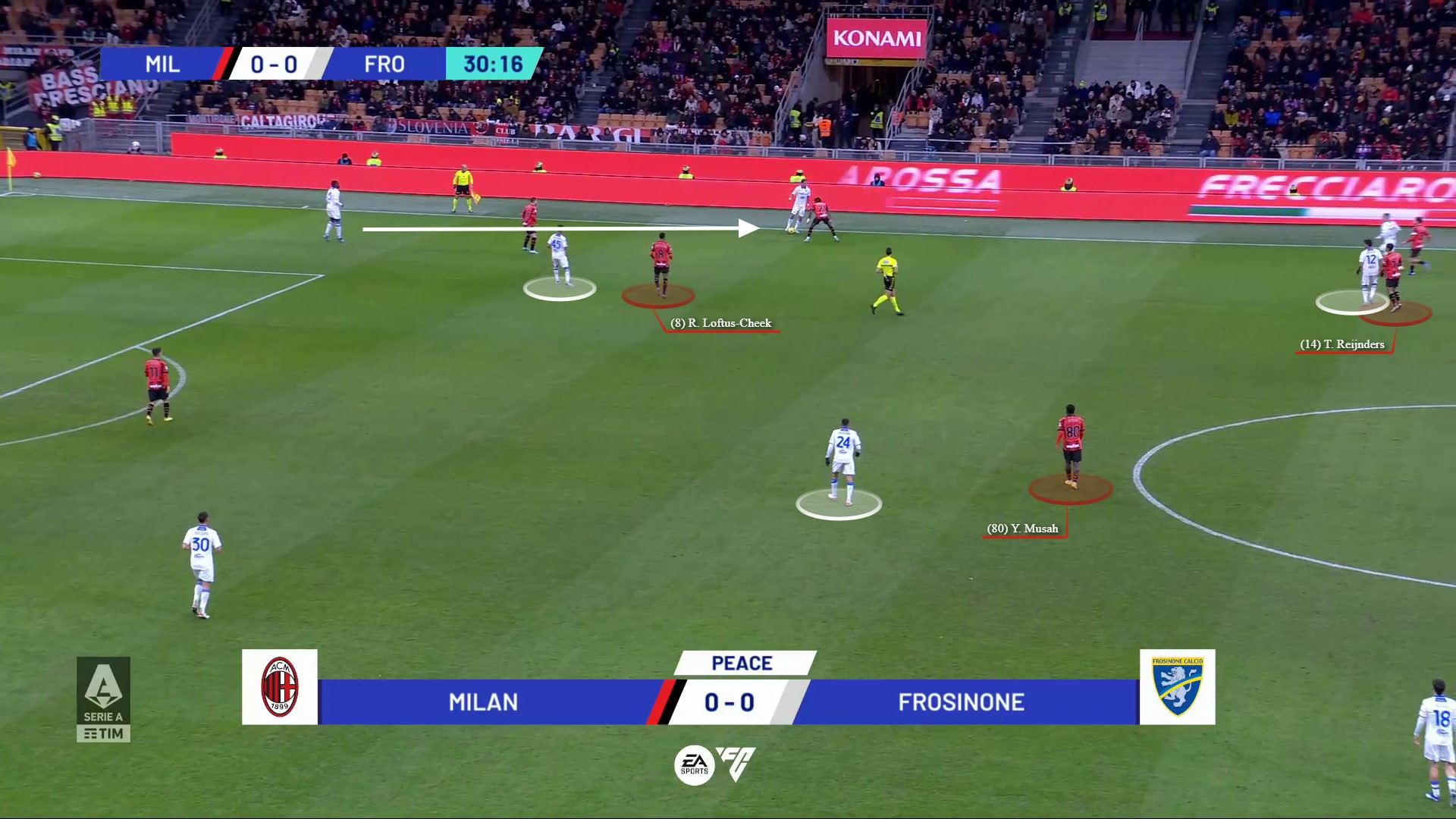
And then executed a one-two to bypass their Milan opponents before exploiting the space they helped manufacture in central midfield (each of the Frosinone midfielders have dragged their man-markers out of the way, a weakness in this system).

Frosinone carried possession into the final third, but with Tomori covering the opposition striker, Hernández was free to jump out of the backline to engage. This helped rush the opponent’s shot which went wide of the Milan goal.
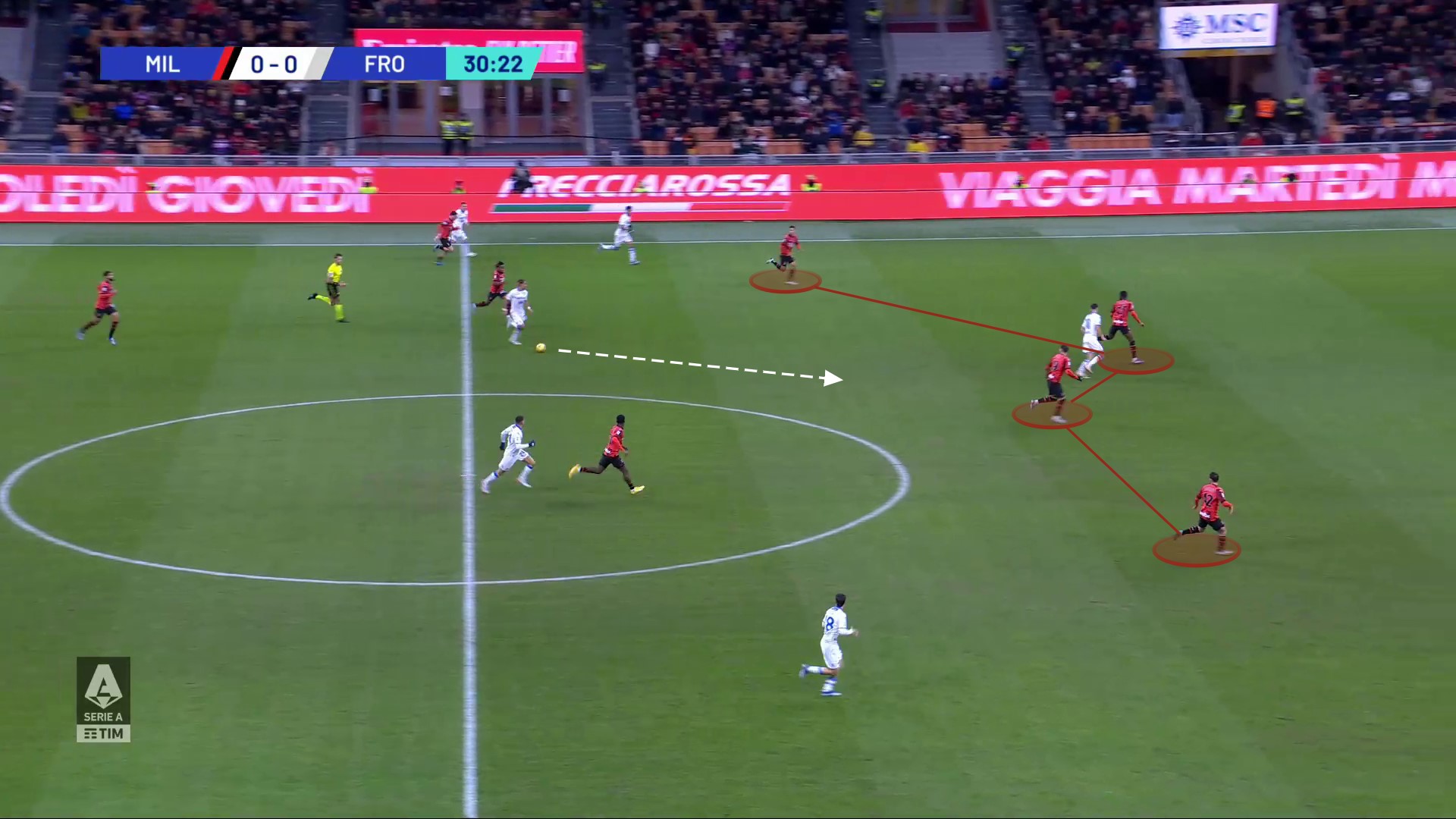

In the second period, Milan maintained this approach out of possession, but as they sat off their opponents more to protect their own half (and lead) there were less spaces for Frosinone to exploit. The home team were therefore able to see out their win, only conceding via a set piece late on.
Takeaways
After a disappointing European result in midweek, a win was the priority for Milan to maintain their hopes of staying in the race for the Scudetto. That’s now six points from six in Serie A after going four games without a win. Next up is Atalanta next weekend, where more accurate judgements of Milan’s quality will be made.


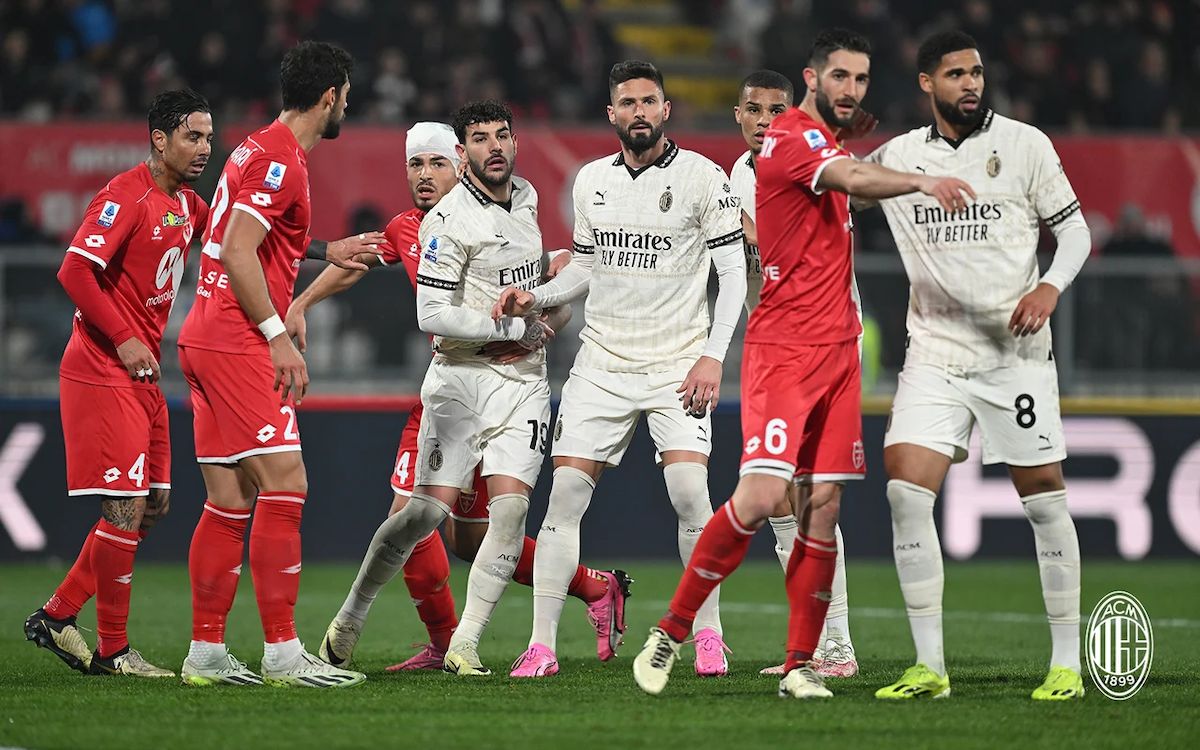
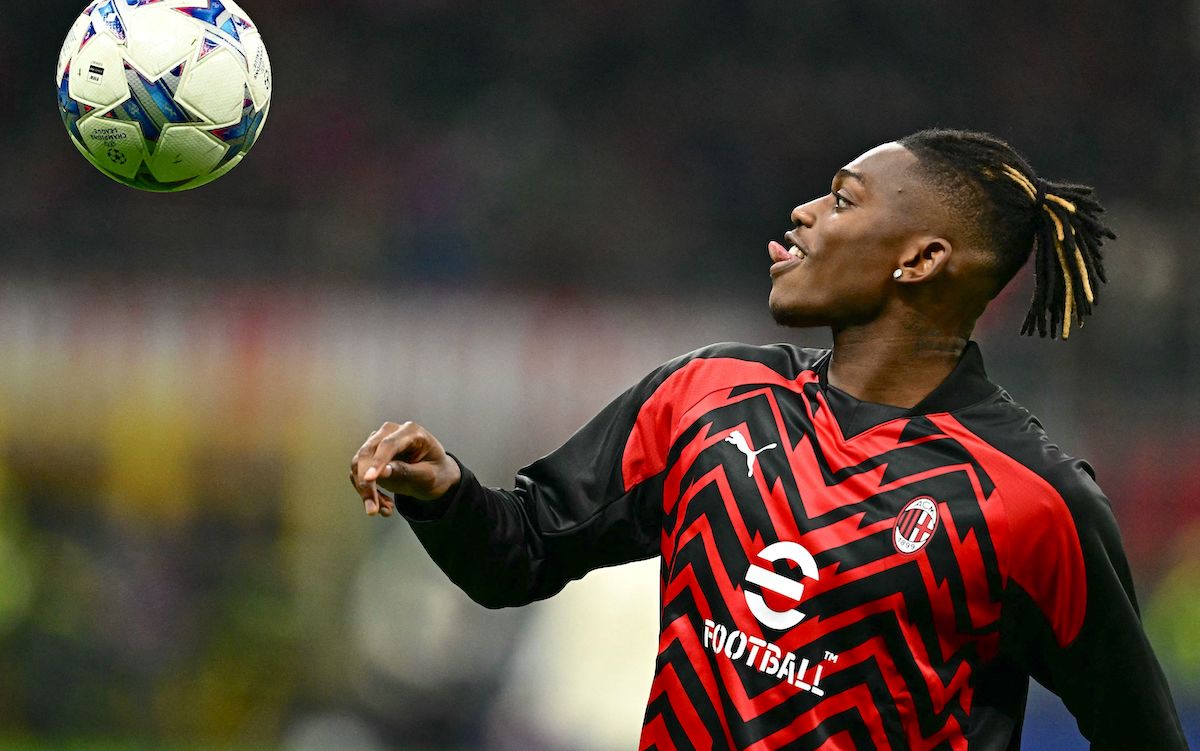


This is a great analysis but i bet most people are not gonna read it when they can brainlessly scream “Pioli out” or “Pioli is an id*ot” in the comment section wether we win, lost, or draw.
Watch again the first half and tell me how many chances Milan had on goal
he is an idi0t and he does need to get fired asap